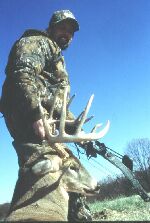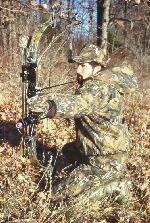
|
Features
|
|
|
|
Books
|
|
|
|
Fun & Games
|
|
|
|
Contact Us
|
|
|
John's Journal... Entry 106, Day 2
DAN PEREZ'S DEER-TAKING TACTICS
Funnel-Forcing Big Bucks
 EDITOR'S
NOTE: Dan Perez of Bowling Green, Missouri, has bowhunted deer for
the past 35 years and has taken 17 official Pope and Young bucks. He also
has several more racks not yet scored that will surely make the P&Y
record book. With outdoorsmen everywhere getting ready for fall and the
beginning of deer season, I talked with Perez about some of his unusual
deer-hunting tactics.
EDITOR'S
NOTE: Dan Perez of Bowling Green, Missouri, has bowhunted deer for
the past 35 years and has taken 17 official Pope and Young bucks. He also
has several more racks not yet scored that will surely make the P&Y
record book. With outdoorsmen everywhere getting ready for fall and the
beginning of deer season, I talked with Perez about some of his unusual
deer-hunting tactics.
QUESTION: Tell me about another weird method you
use for hunting bucks.
ANSWER: Another technique I use that's out of the ordinary is what
I call funnel-forcing. I use two different tactics to funnel-force deer.
Once I killed a nice buck with my bow only 12 yards away using one funnel-forcing
strategy. I hunted a point on an open field that was divided by a fence,
but I couldn't shoot across that entire stretch of field. The deer could
cross the point at five different places. So, I blocked three of those
places with fallen timber after I got permission from the landowner to
do so. I narrowed the deer's crossing places to two pathways within bow
range. I've used this way to funnel deer more than once.
QUESTION: So funnel-forcing cuts down all access
to a particular area -- forcing the deer to use only one or two trails,
correct?
ANSWER: Yes, funnel-forcing reduces the number of trails the deer
can use to the ones closest to me. We have strips of timber in the Midwest
where I mainly hunt that look like fingers. Some of these fingers may
be 400-yards wide, some 200-yards wide, while others are only 100-yards
wide. Usually, five to 10 deer trails run the length of these fingers,
which also may connect to larger bodies of timber or lead into food sources.
I'll set up my funnels before the season begins to avoid scaring off the
deer. If I do it far enough in advance, the deer get accustomed to it.
For my second funnelling method, I run hog wire across
1/2 of one of those arteries of timber, so that the deer crossings are
within a 50-yard distance of each other. I cut it so that my tree stand
is in the middle within 25 yards of the farthest trail. I run the hogwire
diagonally rather than straight, because the deer will walk straight up
to a diagonal fence and follow it. But they will sometimes jump a fence
that runs straight in front of them.
QUESTION: How high is this fence?
ANSWER: Four-feet high.
QUESTION: So you use the hogwire to narrow the
trails down and funnel the deer to within bow range?
ANSWER: Yes, this method works really well. If I don't want to
use the cumbersome hogwire, if I don't have any wire handy or if the farmer
won't permit me to string the wire, I'll use blown-down trash to close
up the trails. I like to use wire because the deer can't go around it,
but they can go around the blown-down trash I stack up. Sometimes, even
if I build a huge barrier, they'll just go down 15 yards and start a new
trail. But the wire forces the deer to continue on the trails you want
them to follow.
 QUESTION:
Do you call that closing down funnels?
QUESTION:
Do you call that closing down funnels?
ANSWER: I call it funnel-forcing. Basically, I just re-direct the
travel. There are a lot of different ways to redirect the deer. Many people
use barbed-wire fences in a reversed method. They pull the top strand
of the barbed wire fence down so that the deer will jump it. But instead
of doing that, if there are no cattle on the land and I have the permission
of the landowner, I'll tie the middle strand down or up. The deer find
it easier to go through the middle of the fence rather than over the top.
TOMORROW: PEREZ TAKES ANOTHER
FUNNELLED BUCK
Check back each day this week for more about Dan Perez...
Day 1 -Different Ways to
Hunt White-tailed Deer
Day 2 -Funnel-Forcing Big Bucks
Day 3 -Perez Takes Another Funnelled Buck
Day 4 -Perez's Snow, Wind and Rain Methods
for Taking White-tailed Deer
Day 5 -Hunting in Urban Areas and In Late
December